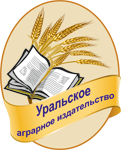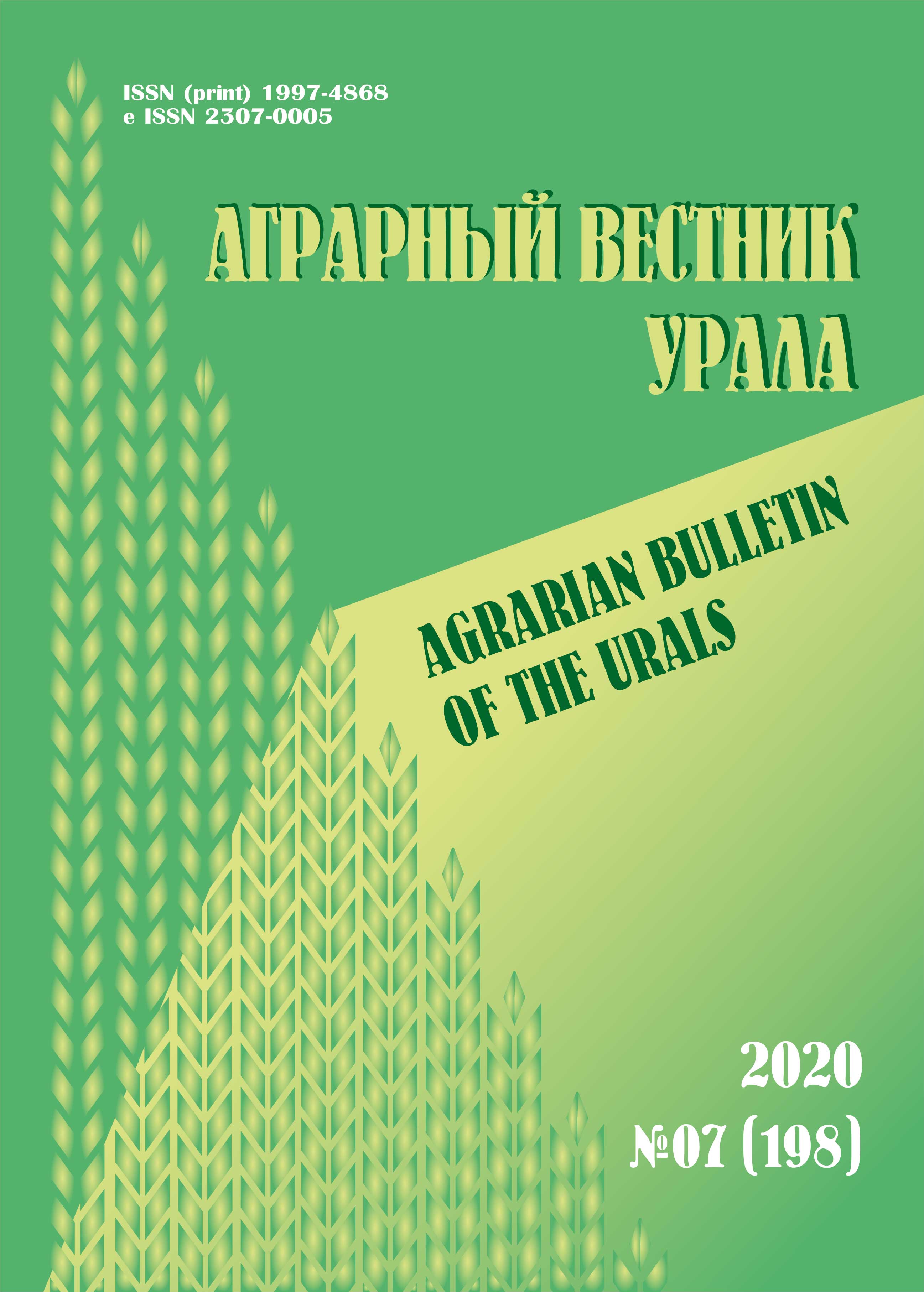Russian Federation
Russian Federation
Yekaterinburg, Russian Federation
Yekaterinburg, Russian Federation
Abstract. The use of medicinal plant extracts in animal production has recently increased due to the discovery of previously unreported side effects of antibiotics, including the cumulation of their toxic metabolites in food, as well as the increased occurrence of antibiotic resistance of microorganisms. Non-therapeutic use of antimicrobials is also associated with the spread of multiple drug resistance, including resistance to antimicrobials that have never been used in animal agriculture. It has long been known that components of plant substances have the ability to inhibit bacterial growth. It is becoming common practice to use plant essential oils to improve feed utilization by ruminants, and essential oils have long been known for their antimicrobial properties. The purpose of this work was to evaluate the metabolic effects of phytobiotic and joint use with antibiotic in controlling microbial load. According to the results obtained, it is clear that phytobiotic in addition to antimicrobial effects has other positive effects expressed in membrane stabilizing and antioxidant properties, but there are some negative effects associated with difficulty of digestion and absorption of lipid nutrients. At the same time, the combined use of phytobiotic and antibiotic showed itself as optimal, due to the good antimicrobial effect, while mitigating or eliminating the negative effects identified when using phytobiotic and enrofloxacin separately, namely, eliminating immunosuppressive and depressive effects, as well as the absence of manifestations of impaired digestion and absorption of fat-soluble nutrients. Scientific novelty. The data obtained will expand the range of antimicrobial agents used in poultry farming, as well as allow the use of more flexible schemes to control the microbial load on the body of birds.
phytobiotics, antibiotics, metabolic effects, laying hens, antimicrobial action
1. Duskaev G. K., Drozdova E. A., Aleshina E. S., Bezryadina A. S. Ocenka vozdeystviya na kishechnuyu mikrofloru pticy veschestv, obladayuschih antibioticheskim, probioticheskim i anti-quorum sensing effektami // Vestnik Orenburgskogo gosudarstvennogo universiteta. 2017. № 11 (211). S. 84-87. EDN: https://elibrary.ru/YLQICW
2. Marshall B. M., Levy S. B. Food animals and antimicrobials: impacts on human health // Clinical Microbiology Reviews. 2011. No. 24 (4). Pp. 718-733. DOI:https://doi.org/10.1128/CMR.00002-11.
3. Borchardt R. A., Rolston K. V. Antibiotic shortages: effective alternatives in the face of a growing problem // Journal of the American Academy of Physician Assistants. 2013. No. 26 (2). Pp. 13-18. DOI:https://doi.org/10.1097/01720610-201302000-00004.
4. Cooper M. A., Shlaes D. Fix the antibiotics pipeline // Nature. 2011. No. 472. Article number 32. DOI:https://doi.org/10.1038/472032a.
5. Seal B. S., Lillehoj H. S., Donovan D. M., Gay C. G. Alternatives to antibiotics: a symposium on the challenges and solutions for animal production // Animal Health Research Reviews. 2013. No. 14 (1). Pp. 78-87. DOI:https://doi.org/10.1017/S1466252313000030.
6. Muhammed A. A., He J. Use of probiotics and botanical extracts to improve ruminant production in the tropics: a review // Animal Nutrition. 2018. No. 4 (3). Pp. 241-249. DOI:https://doi.org/10.1016/j.aninu.2018.04.010.
7. Kuralkar P., Kuralkar S. V. Role of herbal products in animal production - An updated review // The Journal of Ethnopharmacology. 2021. No. 278. Article number 114246. DOI:https://doi.org/10.1016/j.jep.2021.114246. EDN: https://elibrary.ru/CLECKE
8. Huyghebaert G., Ducatelle R., Van Immerseel F. An update on alternatives to antimicrobial growth promoters for broilers // The Veterinary Journal. 2011. No. 187 (2). Pp. 182-188. DOI:https://doi.org/10.1016/j.tvjl.2010.03.003.
9. Lee K. W., Everts H., Kappert H. J., Wouterse H., Frehner M., Beynen A. C. Cinnamaldehyde, but not thymol, counteracts the carboxymethyl cellulose-induced growth depression in female broiler chickens // International journal of poultry science. 2004. No. 3 (9). Pp. 608-612. DOI:https://doi.org/10.3923/ijps.2004.608.612.
10. Stavri M., Piddock L. J., Gibbons S. Bacterial efflux pump inhibitors from natural sources // The Journal of Antimicrobial Chemotherapy. 2007. No. 59 (6). Pp. 1247-1260. DOI:https://doi.org/10.1093/jac/dkl460. EDN: https://elibrary.ru/IQMQJN
11. Windisch W., Schedle K., Plitzer C., Kroismayr A. Use of phytogenic products as feed additives for swine and poultry // Journal of Animal Science. 2008. No. 6 (S14). Pp. E140-E148. DOI:https://doi.org/10.2527/jas.2007-0459.
12. Hashemi S. R., Davoodi H. Phytogenics as new class of feed additives in poultry industry // Journal of Animal and Veterinary Advances. 2010. No. 9 (17). Pp. 2295-2304. DOI:https://doi.org/10.3923/javaa.2010.2295.2304. EDN: https://elibrary.ru/VRENHB
13. Singh J., Gaikwad D. S. Phytogenic feed additives in animal nutrition // In: A. Singh, Yadav (Eds). Natural bioactive products in sustainable agriculture. Singapore: Springer. 2020. Pp. 273-289. DOI:https://doi.org/10.1007/978-981-15-3024-1_13.
14. Ghosh T., Kumar A., Sati A., Mondal B. C., Singh S. K., Kumar R. Effect of dietary supplementation of herbal feed additives (black cumin, garlic and turmeric) in combination with linseed oil on production performance of white leghorn laying chickens // Journal of entomology and zoology studies. 2020. No. 8 (6). Pp. 478-482.
15. Al-Kassie G. A. M. The role of peppermint (Mentha piperita) on performance in broiler diets // Agriculture and Biology Journal of North America. 2010. No. 1 (5). Pp. 1009-1013.
16. Saeed M., Naveed M., Leskovec J., Ali Kamboh A., Kakar I., Ullah K., Ahmad F., Sharif M., Javaid A., Rauf M., Abd El-Hack M. E., Abdel-Latif M. A., Chao S. Using guduchi (Tinospora cordifolia) as an eco-friendly feed supplement in human and poultry nutrition // Poultry Science. 2020. No. 99 (2). Pp. 801-811. DOI:https://doi.org/10.1016/j.psj.2019.10.051.
17. Abad P., Arroyo-Manzanares N., Ariza J. J., Baños A., García-Campaña A. M. Effect of Allium Extract Supplementation on Egg Quality, Productivity, and Intestinal Microbiota of Laying Hens // Animals (Basel). 2020. No. 11 (1). Article number 41. DOI:https://doi.org/10.3390/ani11010041.
18. Ren H., Vahjen W., Dadi T., Saliu E. M., Boroojeni F. G., Zentek J. Synergistic Effects of Probiotics and Phytobiotics on the Intestinal Microbiota in Young Broiler Chicken // Microorganisms. 2019. No. 7 (12). Article number 684. DOI:https://doi.org/10.3390/microorganisms7120684.
19. Meligy A. M. A., El-Hamid M. I. A., Yonis A. E., Elhaddad G. Y., Abdel-Raheem S. M., El-Ghareeb W. R., Mohamed M. H. A., Ismail H., Ibrahim D. Liposomal encapsulated oregano, cinnamon, and clove oils enhanced the performance, bacterial metabolites antioxidant potential, and intestinal microbiota of broiler chickens // Poultry Science. 2023. No. 102 (6). Article number 102683. DOI:https://doi.org/10.1016/j.psj.2023.102683. EDN: https://elibrary.ru/DVBUBJ
20. Laptev G. Y., Yildirim E. A., Ilina L. A., Filippova V. A., Kochish I. I., Gorfunkel E. P., Dubrovin A. V., Brazhnik E. A., Narushin V. G., Novikova N. I., Novikova O. B., Dunyashev T. P., Smolensky V. I., Surai P. F., Griffin D. K., Romanov M. N. Effects of Essential Oils-Based Supplement and Salmonella Infection on Gene Expression, Blood Parameters, Cecal Microbiome, and Egg Production in Laying Hens // Animals (Basel). 2021. No. 11 (2). Article number 360. DOI:https://doi.org/10.3390/ani11020360. EDN: https://elibrary.ru/BJUVNU
21. Swaggerty C. L., Bortoluzzi C., Lee A., Eyng C., Pont G. D., Kogut M. H. Potential Replacements for Antibiotic Growth Promoters in Poultry: Interactions at the Gut Level and Their Impact on Host Immunity // Advances in Experimental Medicine and Biology. 2022. No. 1354. Pp. 145-159. DOI:https://doi.org/10.1007/978-3-030-85686-1_8.
22. Patra A. K., Kar I. Heat stress on microbiota composition, barrier integrity, and nutrient transport in gut, production performance, and its amelioration in farm animals // The Journal of Animal Science and Technology. 2021. No. 63 (2). Pp. 211-247. DOI:https://doi.org/10.5187/jast.2021.e48. EDN: https://elibrary.ru/XJKCAF
23. Attia Y. A., Al-Harthi M. A., Abo El-Maaty H. M. Calcium and Cholecalciferol Levels in Late-Phase Laying Hens: Effects on Productive Traits, Egg Quality, Blood Biochemistry, and Immune Responses // Frontiers in veterinary science. 2020. No. 7. Article number 389. DOI:https://doi.org/10.3389/fvets.2020.00389.
24. Obianwuna U. E., Oleforuh-Okoleh V. U., Wang J., Zhang H. J., Qi G. H., Qiu K., Wu S. G. Natural Products of Plants and Animal Origin Improve Albumen Quality of Chicken Eggs // Frontiers in Nutrition. 2022. No. 9. Article number 875270. DOI:https://doi.org/10.3389/fnut.2022.875270. EDN: https://elibrary.ru/JIRIMW
25. Taha-Abdelaziz K., Hodgins D. C., Lammers A., Alkie T. N., Sharif S. Effects of early feeding and dietary interventions on development of lymphoid organs and immune competence in neonatal chickens: A review // Veterinary Immunology and Immunopathology. 2018. No. 201. DOI:https://doi.org/10.1016/j.vetimm.2018.05.001. EDN: https://elibrary.ru/MDNEDJ
26. Al-Khalaifah H. S. Benefits of probiotics and/or prebiotics for antibiotic-reduced poultry // Poultry Science. 2018. No. 97 (11). Pp. 3807-3815. DOI:https://doi.org/10.3382/ps/pey160.










